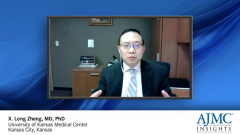
Treatment Options for Acquired TTP
X. Long Zheng, MD, PhD, details the typical healthcare costs for acquired TTP, the treatment options available to patients, and the goals of the healthcare provider.
X. Long Zheng, MD, PhD: What does the health care cost and utilization look like for a typical patient with acquired TTP [thrombotic thrombocytopenic purpura]? As you know, TTP is fatal. If you don’t treat them, the mortality is nearly 100%, or at least greater than 90%. That means once the TTP is suspected or diagnosed, you can never let a patient go home. You should always admit the patient either into the hospital or into intensive care units [ICU]; it depends on how the patient was presented in the emergency department. The treatment is always inside a hospital. Currently, the treatment is actually plasma exchange. So urgent plasma exchange plus corticosteroids, rituximab [Rituxan], as well as the caplacizumab that is newly approved by FDA [Food and Drug Administration]. For health care utilization in terms of TTP itself, if you look at the health care costs as a whole, it’s actually very, very small because you only have very few patients per year in any medical center. In the global sense it doesn’t cost a lot. However, for individual cases, the cost is significant. For example, for plasma exchange or rituximab or caplacizumab, each treatment is about $7,000. Particularly for plasma exchange and caplacizumab, you have to give them every day; every day at least a dose for 1 procedure. With rituximab you only give 4 doses once a week, so it’s not that many. The total therapy is 4 doses, so that does not cost that much. I would say the main costs in health utilization, in terms of treating TTP, are the ICU stay, the hospital admission, therapeutic plasma exchange, and the plasma itself, of course, caplacizumab use, and also the management of long-term complications associated with TTP.
Who typically treats TTP patients? Usually, these patients first get attention by the emergency physician in the ER, or a primary care physician. Then they are transferred to the hospital, the patient gets admitted, and then the hematologist, as well as the transfusion medicine physician like me, will be consulted for plasma exchange. We are the ones that actually conduct the plasma exchange and oversee those patients during the treatment. The hematologists will also work together with us, or the physician in ICU will work with us to add other adjunct therapy like caplacizumab, rituximab, and corticosteroids. We are the ones actually doing that together with the hematology and intensive nurse. In terms of ISTH [International Society on Thrombosis and Haemostasis] guidelines, of course, I’m the chairman for this TTP guideline panel. We were very lucky to have a large panel of internationally renowned hematologists, internal medicine physicians, nephrologists, as well as pathology all work together for 2 years to gather all the evidence, analyze all the evidence, and issue some of the recommendations. This is the first evidence-based international guideline for the diagnosis and the management of TTP. It is sponsored by [an] ISTH educational grant. The panel agreed on 3 recommendations in covering the initial diagnosis, particularly with emphasis on the importance of ADAMTS13 in testing and as well as some of the clinical assessment scores to actually get patient treatment started. Additionally, the panel agreed on 11 treatment recommendations based on the evidence. Of course, the evidence for TTP ranged from very low to moderate certainty. So there’s not a lot of random control the double-blind trial except a HERCULES trial that we will discuss later.
What’s the current treatment option for patient with acquired TTP? ISTH guidelines recommend that every patient should get daily plasma exchange, daily caplacizumab, as well as some immunosuppressive therapy, particularly corticosteroids and rituximab, or some other immunosuppressant as well. We now call this “triple therapy.” Plasma exchange is 1, caplacizumab is 2, and an immunosuppressive is 3, so that’s triple. The immunosuppressive, it can be many different things, but mainly it is corticosteroids and rituximab. This has emerged as the standard care for acquired TTP or immune TTP thus far. The combination of such therapy has significantly reduced the mortality and the health care utilization as well, particularly the ICU stay, and the hospital stay.
What if the plasma exchange is not available in certain hospitals or certain areas? Plasma exchange is not available in every hospital or every region. If you don’t have a plasma exchange, of course the next logical and effective treatment will be giving just a plasma infusion, because the comparator trial—the publisher was published in 1991. The New England Journal of Medicine shows that even if you give plasma infusion, you also can significantly reduce mortality, just not as good as giving the plasma exchange. Therefore, if you don’t have a plasma exchange, give a patient some fresh frozen plasma. So that will also be effective as well. And then you can think about transferring that patient to a center that has a plasma exchange facility.
Transcript edited for clarity.
Newsletter
Stay ahead of policy, cost, and value—subscribe to AJMC for expert insights at the intersection of clinical care and health economics.












